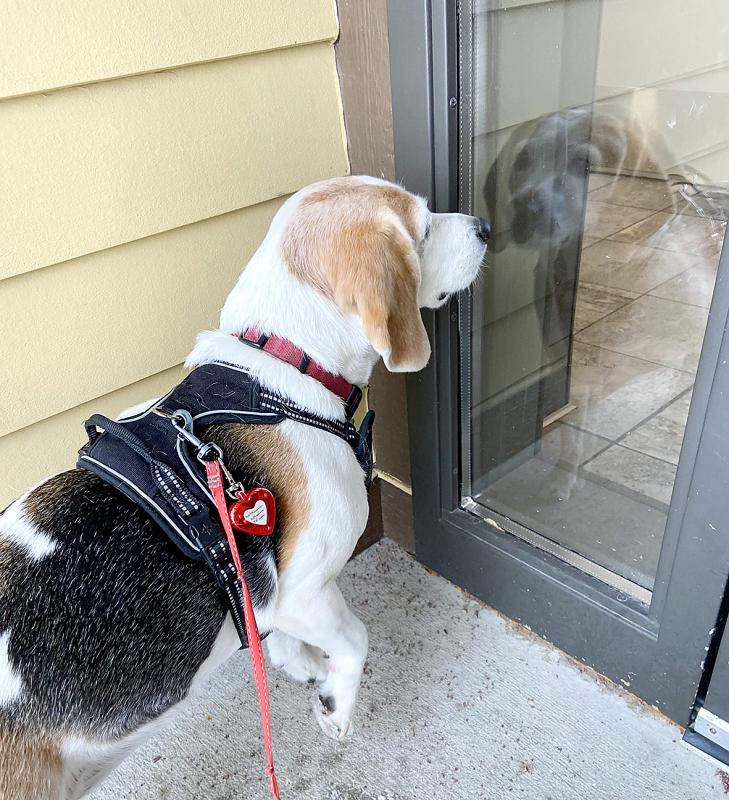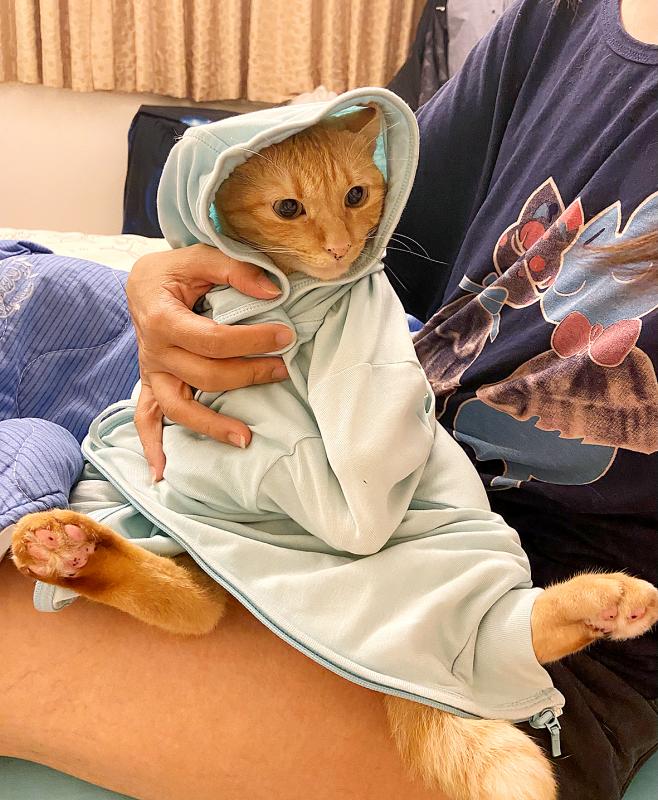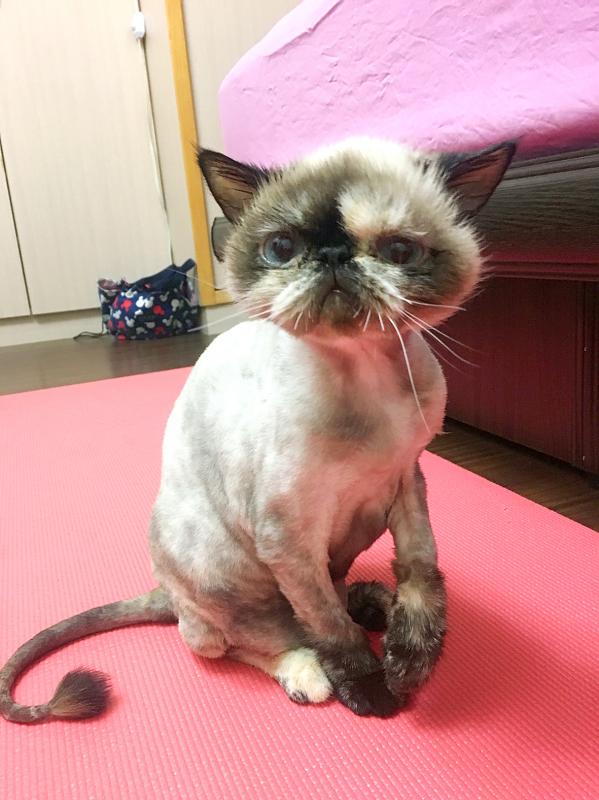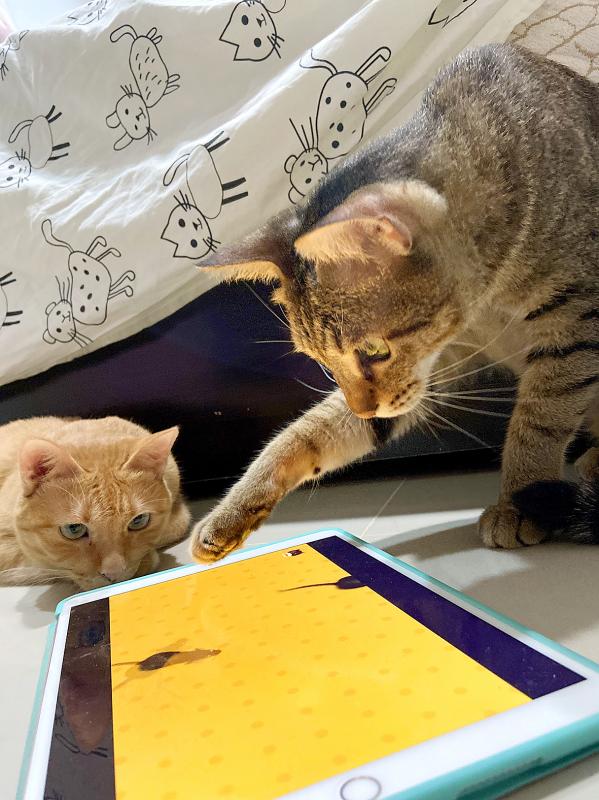In 2020, Lia Tsai (蔡利亞) decided to buy pet insurance after her Himalayan cat racked up a staggering NT$100,000 (US$3,340) in vet bills within its first year. A host of medical problems, including mold in its fluffy long fur, quickly became rows and rows of expenses tracked in her Excel spreadsheet.
After talking to an insurance agent who recommended the company’s most expensive plan, she sat down and began an intense one-night research session. Well versed in personal insurance, she read through each plan’s terms and conditions and realized that many of the advertised offerings were extraneous.
“If I don’t have a dog that roams outside or bites people, why would I need third-party liability insurance?” Tsai says.

Photo: Deanna Durben
That NT$200,000 provision made up 80 percent of the plan’s advertised maximum payout.
Pet insurance can save money and alleviate much of the financial stress around vet visits — but only if buyers are shrewd. With varying options and benefits, it’s easy to be misled by high maximums and flashy perks without considering if they actually suit your needs. Furthermore, insurance won’t cover common preventative care. Or cancer.
It raises the question of whether Taiwanese pet insurance in its current form is even worth it for the average cat or dog owner. (Iguana or clownfish owners are out of luck, as there’s no insurance for rarer pets.) Or if saving money the old-fashioned way is still better.

Photo: Deanna Durben
‘PEACE OF MIND’
Pet insurance is classified under property insurance, and mainly covers sickness or accidental damage. No preventative care is covered — vaccinations, deworming and needed nutritional supplements.
Furthermore, spaying/neutering and pregnancy-related care are considered elective. So is treatment for gum disease, which a majority of pets develop as they grow older.

Photo courtesy of Lia Tsai
Unlike human life insurance plans, yearly renewal is required. This means the companies can arbitrarily reject anyone deemed a liability, including any pet that has a chronic illness or racked up astronomical payouts the previous year.
Tsai originally settled on a cheap NT$600 plan with 50 percent coinsurance, to continue treating her cat’s myriad ongoing problems. When she applied for renewal the following year, they increased her premium to NT$900.
Seven companies offered pet insurance two years ago, when the industry was just beginning to gain traction, but the playing field has since thinned to three providers.

Photo: Deanna Durben
A typical plan costs around NT$3,000 for pets under 8. It includes up to NT$2,000 per vet visit, NT$10,000 for overnight stays and NT$50,000 for surgery. Other perks like liability, cremation fees or even locating a missing pet, vary widely between plans.
Halfway house Furiend (狗抵家) owner Hsiao Mei-fang (蕭媚方) also bought pet insurance after her dog had a series of skin problems. That year, they didn’t visit the vet once.
Nevertheless, Hsiao also insured her other two dogs the following year, after discovering a special mixed-breed policy (costing NT$$937 for their age bracket). It insures up to NT$1,100 per vet visit, but they’ve only had to go three times.
“Buying some peace of mind is definitely worth it,” Hsiao says. “Even though we didn’t use the insurance, at least we never had to worry about something happening to our pets.”
RAINY DAY FUND
However, having peace of mind means the exact opposite decision for Chiu Yan (邱雁).
Chiu, who owns four cats, says that “simply putting money aside is the most practical choice.” With varying coverage for different illnesses and treatments, it’s hard to predict what reimbursement applications will be accepted, she says, which can result in unexpected high costs.
“Your pet being sick is stressful and chaotic enough, without having to guess what procedures are covered,” Chiu says.
Furthermore, most plans stop coverage at the age of 10 or 12. Chiu couldn’t insure her oldest 14-year-old cat even if she wanted to.
Yet older pets are more likely to develop serious problems. Chiu’s cats had minimal expenses before the age of seven, then one major problem costing around NT$20,000 every two years.
Instead, Chiu has a bank account earmarked for pet care.
“Having the discipline to save regularly can be a challenge,” she says, but she believes it’s a better choice.
She saves NT$1,000 per month per cat.
“Twelve thousand per year may seem excessive in their young years, but it makes more sense than buying an insurance policy you don’t need,” she says, choosing to slowly accumulate an emergency fund.
Simple saving is an option that definitely bears consideration — and inevitably must happen as pets age out of coverage.
Insurance is a choice based on individual situations, although agents working on commission will inevitably try to convince you otherwise. In popular pet Facebook groups like Love Cat Club (愛貓聯盟), which has almost half a million members, posting anything about insurance will garner a barrage of enthusiastic comments or messages from agents.
Tsai made a popular post in 2020 detailing the restrictions and drawbacks of pet insurance — often hidden in the fine print. As thankful comments piled up, so did angry messages from insurance reps asking her to remove the post, even though she was just compiling publicly available information.
FINDING GOOD ADVICE
Good advice is hard to find. Other players in the pet care business, like pet stores and veterinary practices, don’t seem to get involved.
“It’s a purely economic decision for pet owners,” says veterinarian Yen chin-fang (顏進芳) of Tzu-en Animal Hospital (慈恩動物醫院), “so we don’t get involved.”
Clinics merely provide a receipt and diagnostic report, which can cost between NT$200 and NT$500.
When buying her current plan, Tsai asked a non-affiliated agent to present all the options, then went home to decide what policy actually fit her cat’s needs. She ended up with a NT$3,000 plan that has more than paid for itself.
Both dismissing insurance’s potential benefits and blindly buying can be foolish choices. Pet owners should analyze their own expenses and future expectations to see if any available insurance offerings match their needs.
Skipping careful consideration could leave someone missing out on major compensation or, as Tsai puts it, “subsidizing those of us who do use the insurance.”

In the March 9 edition of the Taipei Times a piece by Ninon Godefroy ran with the headine “The quiet, gentle rhythm of Taiwan.” It started with the line “Taiwan is a small, humble place. There is no Eiffel Tower, no pyramids — no singular attraction that draws the world’s attention.” I laughed out loud at that. This was out of no disrespect for the author or the piece, which made some interesting analogies and good points about how both Din Tai Fung’s and Taiwan Semiconductor Manufacturing Co’s (TSMC, 台積電) meticulous attention to detail and quality are not quite up to

April 21 to April 27 Hsieh Er’s (謝娥) political fortunes were rising fast after she got out of jail and joined the Chinese Nationalist Party (KMT) in December 1945. Not only did she hold key positions in various committees, she was elected the only woman on the Taipei City Council and headed to Nanjing in 1946 as the sole Taiwanese female representative to the National Constituent Assembly. With the support of first lady Soong May-ling (宋美齡), she started the Taipei Women’s Association and Taiwan Provincial Women’s Association, where she

It is one of the more remarkable facts of Taiwan history that it was never occupied or claimed by any of the numerous kingdoms of southern China — Han or otherwise — that lay just across the water from it. None of their brilliant ministers ever discovered that Taiwan was a “core interest” of the state whose annexation was “inevitable.” As Paul Kua notes in an excellent monograph laying out how the Portuguese gave Taiwan the name “Formosa,” the first Europeans to express an interest in occupying Taiwan were the Spanish. Tonio Andrade in his seminal work, How Taiwan Became Chinese,

Mongolian influencer Anudari Daarya looks effortlessly glamorous and carefree in her social media posts — but the classically trained pianist’s road to acceptance as a transgender artist has been anything but easy. She is one of a growing number of Mongolian LGBTQ youth challenging stereotypes and fighting for acceptance through media representation in the socially conservative country. LGBTQ Mongolians often hide their identities from their employers and colleagues for fear of discrimination, with a survey by the non-profit LGBT Centre Mongolia showing that only 20 percent of people felt comfortable coming out at work. Daarya, 25, said she has faced discrimination since she